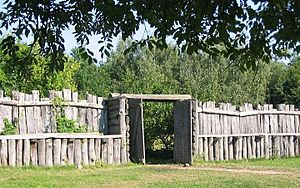Palisade facts for kids

A palisade is like a strong fence or wall made from many tall, pointed wooden posts or tree trunks. People used them long ago as a way to protect their homes, villages, or forts. Sometimes, they are also called a stakewall or a paling. These walls could form a stockade, which is a type of enclosed area.
Contents
What's in a Name?
The word "palisade" comes from an old Latin word, pālus. This word means "stake" or "post." So, a palisade is basically a wall made of many stakes placed side by side.
How They Were Built
Palisades were usually made from small or medium-sized tree trunks. These trunks were placed upright in the ground, very close together, with hardly any gaps. The tops of the trunks were often sharpened to a point. Sometimes, extra wood or dirt was added to make them even stronger.
These walls could be anywhere from about 1 meter (3 feet) to 4 meters (13 feet) tall. People often built palisades along with earthworks, which are mounds or ditches made of earth. This made the defenses even tougher.
Palisades were great for building small forts quickly. Since they were made of wood, people could often find materials nearby and build them fast. They worked well for short fights and could stop small groups of attackers. However, because they were made of wood, they could easily catch fire. They also weren't very strong against big siege weapons, like catapults.
Sometimes, a palisade was built around a castle. It served as a temporary wall until a stronger, permanent stone wall could be built.
Ancient Greece and Rome
Both the Greeks and Romans used palisades to protect their army camps. A Roman historian named Livy wrote that the Greek method was not as good as the Roman one. The Greek stakes were too big to carry easily. Also, they were placed too far apart. This made it simple for enemies to pull them out and create a big gap to get inside.
The Romans, however, used smaller stakes that were easier to carry. They placed their stakes much closer together. This made it very hard for enemies to pull them out.
Native American Settlements

Many Iroquoian peoples, who lived around the Great Lakes, protected their villages with palisades. Inside these walls, people lived in large communal homes called longhouses. Some of these communities had as many as 2,000 people. Scientists have found evidence of these palisades at many sites from the 1400s and 1500s in Canada and the United States.
Many villages of the Mississippian culture in the central United States also used palisades. A famous example is the Cahokia Mounds site in Collinsville, Illinois. A wooden stockade with watchtowers was built around the main area of Cahokia. It was about 3.2 kilometers (2 miles) long. This wall seemed to separate the main ceremonial area from other parts of the city. It also served as a defense. Scientists have found signs that this stockade was rebuilt several times.
Other places with palisades include the Angel Mounds site in Indiana, Aztalan State Park in Wisconsin, and the Etowah site in Georgia.
Colonial America
When Europeans first settled in America, palisaded villages were common. They helped protect the settlers from wild animals and sometimes from conflicts with indigenous peoples. The first English settlements in Jamestown, Virginia (1607) and Plymouth, Massachusetts (1620) were both originally fortified towns surrounded by palisades.
Palisades were also used often in New France, which was the French part of North America. Sometimes, houses were even built using vertical posts as walls. This style was called poteaux en terre. Some houses from the 1700s built in this way can still be seen in Ste. Genevieve, Missouri.
Ottoman Empire Forts
The Ottoman Empire built a type of wooden fort called a "palanka" in the Balkans during the 1500s and 1600s. These forts were made of palisades. They were built for different reasons, like protecting an important area or a town. Some palankas even grew into larger settlements over time.
Modern Uses

In some countries, like South Africa, where there is a lot of crime, people use palisade fences to protect their homes. These can be made of steel or wood. Some even have electricity running through them to deter intruders.
The City of Johannesburg actually suggests using palisade fences instead of solid brick walls. This is because criminals cannot hide as easily behind a fence. The city even gives advice on how to use them safely, like not having plants grow next to the fence, which could help criminals hide.
See also
 In Spanish: Empalizada para niños
In Spanish: Empalizada para niños




